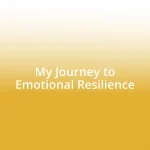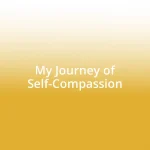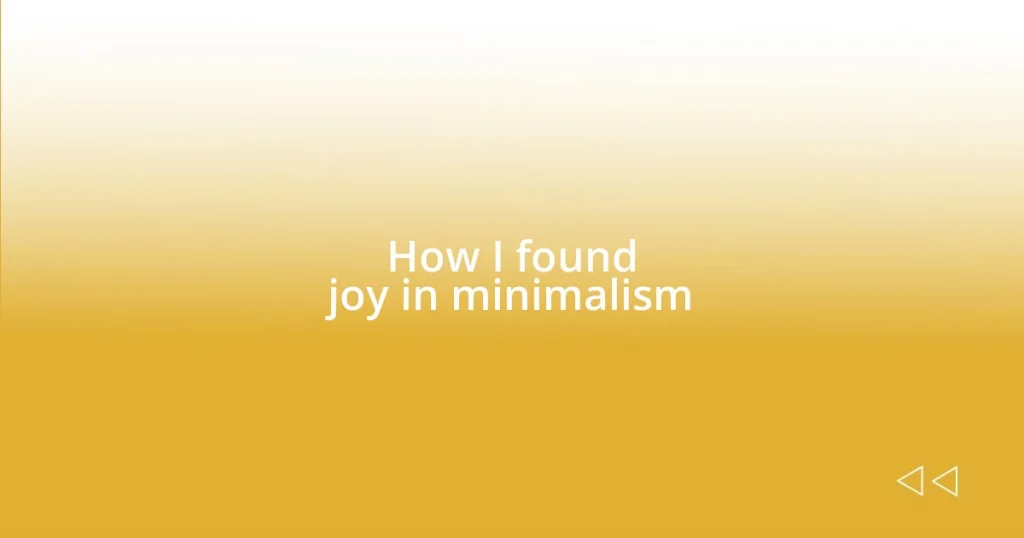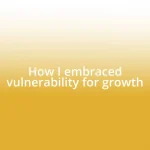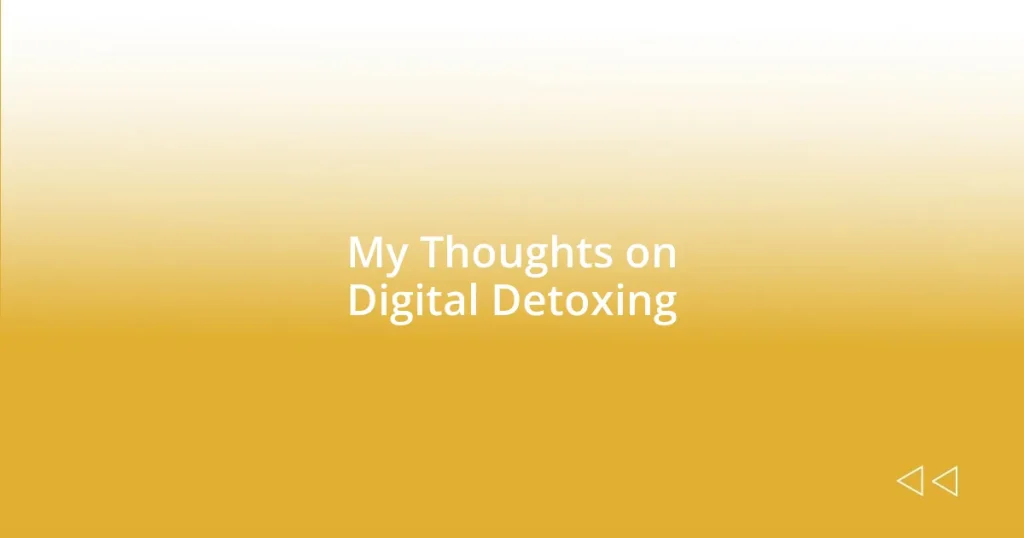Key takeaways:
- Minimalism promotes intentional living by encouraging individuals to focus on what genuinely brings happiness and reduces distractions.
- Identifying and letting go of both physical and emotional clutter can lead to mental clarity and enhanced well-being.
- Practical decluttering steps, such as starting small and implementing the “one in, one out” rule, can make the process manageable and rewarding.
- Sharing the journey of minimalism with others fosters community, emotional growth, and deeper appreciation for what truly matters in life.

Understanding minimalism philosophy
Minimalism isn’t just about decluttering your space; it’s a way of approaching life with intention. I remember standing in front of my overflowing closet, feeling overwhelmed by the sheer volume of clothes I hardly wore. It hit me then: how much time and energy was I wasting on things that didn’t spark joy?
At its core, minimalism encourages us to focus on what truly matters. I often ask myself, “What brings me genuine happiness?” This mindset shift allowed me to let go of material possessions and habits that no longer served me. I realized that by reducing the noise in my life, I could pay more attention to relationships, experiences, and personal growth.
Embracing minimalism has also taught me the beauty of simplicity. On a particularly hectic day, when I stripped away distractions, I found solace in a quiet morning cup of tea. It was a reminder that joy doesn’t reside in possessions but in moments that allow us to breathe deeply and appreciate the present.

Identifying clutter in my life
Identifying clutter in my life was a journey that required real honesty. When I began the process, it was eye-opening to see how my home mirrored my mind—stuff everywhere, creating a backdrop of chaos. I recall sitting surrounded by books I had intended to read, each one a silent guilt trip. It dawned on me that my affection for learning was being overshadowed by these unread volumes.
After digging deeper, I realized that clutter wasn’t just physical. Emotional clutter, too, loomed large; negative thoughts and unfulfilled commitments weighed heavily on my spirit. I had to confront things that drained my energy but that I clung to out of habit. I remember a friend once advised me to be ruthless in my assessment. Each item needed to earn its place in my life, and that perspective was transformative.
As I began letting go, the weight lifted, and I began to see connections between what I owned and how I felt. The more I sorted through my belongings, the clearer I became about my priorities. Reflecting on that experience, I learned that identifying clutter isn’t merely about tossing items—it’s about understanding what truly adds value to my life.
| Types of Clutter | Personal Experience |
|---|---|
| Physical Clutter | Overwhelmed by books I never read. |
| Emotional Clutter | Negative thoughts kept me from enjoying life. |
| Digital Clutter | Endless email subscriptions that drained my attention. |
| Social Clutter | Engaging in relationships that didn’t enrich my life. |

Practical steps to declutter
Taking practical steps to declutter is where the magic happens. I initially found myself stuck, unsure of where to begin. Then, I discovered that breaking my clutter removal into bite-sized tasks made the process manageable and surprisingly enjoyable. Setting a timer for just 15 minutes allowed me to focus on one area at a time, transforming daunting spaces into achievable goals.
Here are some effective steps to get started:
- Start small: Choose a single drawer or shelf to tackle first.
- Use the “one in, one out” rule: For every new item that enters your home, let go of something old.
- Commit to a daily declutter: Spend a few minutes each day removing items you no longer need.
- Sort into categories: Create piles for keep, donate, and toss as you sort through items.
- Emotional check-ins: Ask yourself how each item makes you feel; if it doesn’t spark joy, consider letting it go.
By embracing these steps, I uncovered layers of both physical and emotional clutter that I hadn’t realized were weighing me down. Each item I chose to let go felt like shedding a piece of the past, and in those moments, I found clarity.

Creating a minimalist living space
Creating a minimalist living space begins with being intentional about what goes in it. When I first started decluttering, I remember standing in my living room, overwhelmed by the mismatched furniture and knickknacks. I posed a simple question to myself: “Does this piece truly enhance my experience here?” That mindset shift encouraged me to let go of items I had kept out of obligation rather than joy.
The process of selecting furniture and decor became a delightful journey of discovery. I found myself gravitating toward a few well-chosen pieces that were not only functional but also meaningful. For instance, instead of cluttering my walls with countless photos, I decided to highlight a single, large piece of art that sparks happiness every time I walk by. Choosing to curate my space rather than just fill it made every corner feel intentional and alive.
Lighting also played a pivotal role in transforming my living area. I vividly remember swapping out harsh overhead lights for soft, warm lamps, instantly creating an inviting atmosphere. Just like a chef seasons their dish to perfection, adjusting the lighting breathed life into my minimalist space. I realized that the ambiance I created was as much about what I didn’t include as what I did, inviting a sense of calm and clarity into my daily life. What changes are you inspired to make in your space?

Benefits of minimalism on well-being
Embracing minimalism has profoundly enhanced my overall well-being. I’ve noticed that with fewer possessions, my mind feels clearer and less cluttered. It’s fascinating how this mental clarity allows me to focus more on what truly matters in my life, like nurturing relationships and pursuing passions that bring me joy.
The emotional benefits of minimalism are also striking. When I decided to let go of items that no longer served me, it felt both liberating and grounding. I still remember the weight lifting off my shoulders as I donated clothes I hadn’t worn in years. Each item released symbolized a burden I no longer needed to carry, opening up space for new experiences and opportunities.
Additionally, living minimally helps me cultivate gratitude and mindfulness. I find myself appreciating the few treasured items I own much more deeply. For instance, instead of mindlessly scrolling through my belongings, I take a moment to truly enjoy that beautiful mug I sip my morning coffee from. Have you ever noticed how much a simple object can enhance your daily rituals when it’s intentional? It’s incredible to witness how minimalism transforms not just my space, but my heart and mind as well.

Maintaining a minimalist lifestyle
Maintaining a minimalist lifestyle requires ongoing commitment and self-reflection. I often pause to reevaluate what I truly need and what adds value to my life. This practice has led to moments where I’ve hesitated before purchasing items, asking myself, “Will this really improve my day-to-day experience?” This simple question often stops unnecessary clutter from creeping back in.
One technique I use is a seasonal audit of my belongings. I recall a particularly enlightening spring cleaning session where I tackled my wardrobe. As I pulled out clothes that hadn’t been worn for months, a surprising wave of clarity washed over me. I realized how much emotional energy I had spent deciding what to wear each day. By letting go of the excess, I not only freed up space but also simplified my mornings, enhancing my overall well-being.
Creating boundaries around consumer habits has also been essential for me. I’ve set strict guidelines for myself, like implementing a “one in, one out” rule for new purchases. This way, every new item comes with the responsibility of letting go of something else. How liberating it feels to walk into my home knowing that each piece has a purpose! The joy of minimalism lies not just in having less, but in cherishing the life I’ve crafted from intentional choices.

Sharing minimalism joy with others
Sharing the joy of minimalism with others has been one of the most fulfilling aspects of my journey. I remember hosting a small gathering where I introduced friends to my minimalist lifestyle. We explored my living space, and it sparked vibrant discussions about what truly adds value to our lives. How often do we stop and evaluate our belongings together? That evening was filled with laughter, epiphanies, and a collective sense of freedom in letting go.
I’ve also started a local community group focused on decluttering and minimalism. One particular session stands out to me; someone shared how it was challenging to part with items that held sentimental value. I shared my own struggles with similar items and how passing them on can be a way to honor memories without carrying the physical weight. It’s touching to see others realizing that our emotional ties to things don’t have to mean we keep them. This emotional exchange not only strengthens our bonds but also helps everyone embrace this lifestyle with more ease.
Moreover, I often recommend mindfulness practices that accompany minimalism to friends. The other day, I encouraged a friend to take a mindful approach while sorting through her belongings. Instead of rushing through, I suggested she pause to reflect on her connection to each item. The transformation in her mindset was evident—she began seeing decluttering as a personal growth opportunity rather than just a task. Don’t you think that slowing down will help us appreciate the process even more? Sharing these insights proves that minimalism is not just about what we own, but about how we experience life itself.





